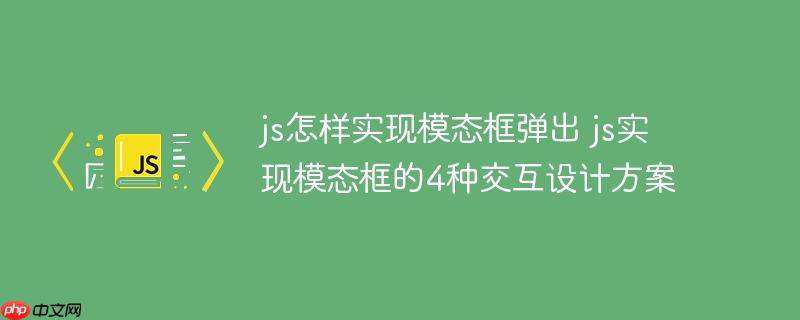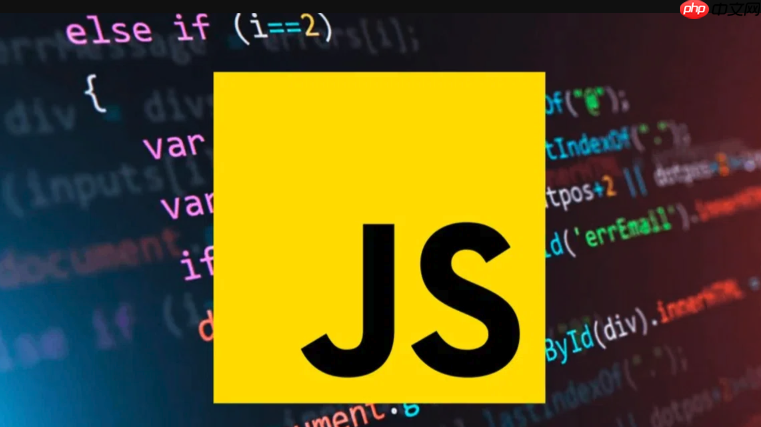實現(xiàn)模態(tài)框的核心在于控制html元素的顯示隱藏及交互邏輯,1. html結構需包含遮罩層與內(nèi)容區(qū)域;2. css設置初始隱藏及彈出樣式;3. JavaScript控制顯示、隱藏及交互事件。四種實現(xiàn)方案分別為:基礎模態(tài)框通過display屬性切換顯隱;動畫模態(tài)框使用transition與類控制動畫;事件委托優(yōu)化多按鈕場景;promise模態(tài)框返回異步結果。兼容性方面需注意舊瀏覽器對classlist、position: fixed及css動畫的支持問題。可借助jquery ui、bootstrap等庫簡化實現(xiàn),亦可通過ajax加載遠程內(nèi)容。無障礙設計應使用aria屬性、鍵盤導航、焦點管理以適配屏幕閱讀器。

實現(xiàn)模態(tài)框,本質(zhì)上就是控制html元素的顯示與隱藏,并處理一些額外的交互邏輯,讓它看起來更像一個“模態(tài)”的窗口。

解決方案

實現(xiàn)模態(tài)框的核心在于:

- HTML結構: 創(chuàng)建模態(tài)框的HTML結構,包括遮罩層和內(nèi)容區(qū)域。
- CSS樣式: 設置模態(tài)框的初始狀態(tài)(隱藏),以及彈出時的樣式(顯示,定位等)。
- JavaScript控制: 使用JavaScript控制模態(tài)框的顯示與隱藏,以及處理一些交互事件,比如點擊遮罩層關閉模態(tài)框。
下面是4種交互設計方案的JS實現(xiàn)思路:
方案一:基礎模態(tài)框
<div id="myModal" class="modal"> <div class="modal-content"> <span class="close">×</span> <p>Some text in the Modal!</p> </div> </div> <button id="myBtn">Open Modal</button> <style> /* 初始隱藏 */ .modal { display: none; position: fixed; /* Stay in place */ z-index: 1; /* Sit on top */ left: 0; top: 0; width: 100%; /* Full width */ height: 100%; /* Full height */ overflow: auto; /* Enable scroll if needed */ background-color: rgb(0,0,0); /* Fallback color */ background-color: rgba(0,0,0,0.4); /* Black w/ opacity */ } .modal-content { background-color: #fefefe; margin: 15% auto; /* 15% from the top and centered */ padding: 20px; border: 1px solid #888; width: 80%; /* Could be more or less, depending on screen size */ } .close { color: #aaa; float: right; font-size: 28px; font-weight: bold; } .close:hover, .close:focus { color: black; text-decoration: none; cursor: pointer; } </style> <script> // 獲取元素 var modal = document.getElementById("myModal"); var btn = document.getElementById("myBtn"); var span = document.getElementsByClassName("close")[0]; // 點擊按鈕,打開模態(tài)框 btn.onclick = function() { modal.style.display = "block"; } // 點擊 <span> (x), 關閉模態(tài)框 span.onclick = function() { modal.style.display = "none"; } // 點擊模態(tài)框外部, 關閉模態(tài)框 window.onclick = function(event) { if (event.target == modal) { modal.style.display = "none"; } } </script>
JS:獲取按鈕、模態(tài)框和關閉按鈕的元素。 通過 onclick 事件監(jiān)聽器控制模態(tài)框的顯示和隱藏。點擊遮罩層也會關閉模態(tài)框。
方案二:動畫效果的模態(tài)框
在方案一的基礎上,增加CSS動畫,讓模態(tài)框的彈出和關閉更平滑。
.modal { /* ... 其他樣式 */ opacity: 0; transition: opacity 0.3s ease; } .modal.show { display: block; opacity: 1; }
JS:
btn.onclick = function() { modal.classList.add("show"); } span.onclick = function() { modal.classList.remove("show"); } window.onclick = function(event) { if (event.target == modal) { modal.classList.remove("show"); } }
關鍵點:使用classList.add和classList.remove來添加和移除CSS類,觸發(fā)CSS動畫。
方案三:使用事件委托
如果頁面上有多個按鈕需要打開模態(tài)框,可以使用事件委托來簡化代碼。
<div data-modal-target="#myModal1">Open Modal 1</div> <div data-modal-target="#myModal2">Open Modal 2</div> <div id="myModal1" class="modal">...</div> <div id="myModal2" class="modal">...</div> <script> document.addEventListener('click', function(event) { if (event.target.hasAttribute('data-modal-target')) { const modalId = event.target.getAttribute('data-modal-target'); const modal = document.querySelector(modalId); modal.classList.add('show'); event.preventDefault(); // 阻止默認行為,比如鏈接跳轉(zhuǎn) } if (event.target.classList.contains('close') || event.target.classList.contains('modal')) { const modal = event.target.closest('.modal'); // 找到最近的.modal父元素 if(modal) { modal.classList.remove('show'); } } }); </script>
JS:監(jiān)聽整個文檔的點擊事件。如果點擊的元素有data-modal-target屬性,則打開對應的模態(tài)框。 事件委托減少了事件監(jiān)聽器的數(shù)量,提高了性能。
方案四:使用Promise的模態(tài)框
讓模態(tài)框可以返回一個Promise,用于處理模態(tài)框關閉后的邏輯。
function showModal(content) { return new Promise((resolve, reject) => { // 創(chuàng)建模態(tài)框元素 const modal = document.createElement('div'); modal.classList.add('modal'); modal.innerHTML = ` <div class="modal-content"> <span class="close">×</span> <p>${content}</p> <button class="confirm">Confirm</button> <button class="cancel">Cancel</button> </div> `; document.body.appendChild(modal); modal.classList.add('show'); // 獲取按鈕 const confirmButton = modal.querySelector('.confirm'); const cancelButton = modal.querySelector('.cancel'); const closeButton = modal.querySelector('.close'); // 監(jiān)聽按鈕點擊事件 confirmButton.addEventListener('click', () => { modal.classList.remove('show'); setTimeout(() => modal.remove(), 300); // 等待動畫結束后移除 resolve(true); }); cancelButton.addEventListener('click', () => { modal.classList.remove('show'); setTimeout(() => modal.remove(), 300); resolve(false); }); closeButton.addEventListener('click', () => { modal.classList.remove('show'); setTimeout(() => modal.remove(), 300); reject(new Error('Modal closed without confirmation')); }); modal.addEventListener('click', (e) => { if(e.target === modal) { modal.classList.remove('show'); setTimeout(() => modal.remove(), 300); reject(new Error('Modal closed by clicking outside')); } }); }); } // 使用示例 document.getElementById('myBtn').addEventListener('click', () => { showModal('Are you sure you want to continue?') .then(result => { if (result) { console.log('User confirmed'); } else { console.log('User cancelled'); } }) .catch(error => { console.error('Modal error:', error.message); }); });
JS:showModal函數(shù)返回一個Promise。 點擊“Confirm”按鈕resolve Promise,點擊“Cancel”按鈕reject Promise。 使用then和catch處理模態(tài)框關閉后的邏輯。
模態(tài)框在不同瀏覽器上的兼容性問題有哪些?
模態(tài)框的兼容性問題主要集中在CSS和JavaScript上。例如,某些舊版本的瀏覽器可能不支持classList API,需要使用className來替代。 CSS動畫的兼容性也需要考慮,可以使用CSS前綴來解決。 另外,ie瀏覽器對position: fixed的支持可能存在問題,需要使用JavaScript來模擬。
如何使用JavaScript庫簡化模態(tài)框的實現(xiàn)?
可以使用jQuery UI、bootstrap、Materialize等JavaScript庫來簡化模態(tài)框的實現(xiàn)。 這些庫提供了現(xiàn)成的模態(tài)框組件,可以快速集成到項目中。 例如,使用Bootstrap的模態(tài)框:
<!-- HTML --> <button type="button" class="btn btn-primary" data-toggle="modal" data-target="#myModal"> Open modal </button> <div class="modal fade" id="myModal" tabindex="-1" role="dialog" aria-labelledby="myModalLabel"> <div class="modal-dialog" role="document"> <div class="modal-content"> <div class="modal-header"> <button type="button" class="close" data-dismiss="modal" aria-label="Close"><span aria-hidden="true">×</span></button> <h4 class="modal-title" id="myModalLabel">Modal title</h4> </div> <div class="modal-body"> ... </div> <div class="modal-footer"> <button type="button" class="btn btn-default" data-dismiss="modal">Close</button> <button type="button" class="btn btn-primary">Save changes</button> </div> </div> </div> </div> <!-- JavaScript (需要引入jQuery和Bootstrap JS) --> <script> $('#myModal').modal(); // 初始化模態(tài)框 </script>
只需要引入jQuery和Bootstrap的CSS和JS文件,然后使用$(‘#myModal’).modal()即可初始化模態(tài)框。
如何在模態(tài)框中加載遠程內(nèi)容?
可以使用AJAX技術在模態(tài)框中加載遠程內(nèi)容。 例如,當點擊打開模態(tài)框的按鈕時,使用fetch API或XMLHttpRequest對象從服務器獲取數(shù)據(jù),然后將數(shù)據(jù)插入到模態(tài)框的內(nèi)容區(qū)域。
document.getElementById('myBtn').addEventListener('click', () => { fetch('https://example.com/api/data') .then(response => response.text()) .then(data => { document.querySelector('#myModal .modal-body').innerHTML = data; $('#myModal').modal('show'); // 使用Bootstrap打開模態(tài)框 }) .catch(error => { console.error('Error fetching data:', error); }); });
JS:使用fetch API從https://example.com/api/data獲取數(shù)據(jù)。 將獲取到的數(shù)據(jù)插入到#myModal .modal-body元素中。 使用$(‘#myModal’).modal(‘show’)打開模態(tài)框。
模態(tài)框的無障礙性(Accessibility)如何考慮?
模態(tài)框的無障礙性非常重要,需要考慮以下幾點:
- 使用aria-屬性: 使用aria-labelledby和aria-describedby屬性來關聯(lián)模態(tài)框的標題和描述。 使用aria-hidden=”true”屬性來隱藏模態(tài)框。
- 鍵盤導航: 確保可以使用鍵盤導航模態(tài)框中的元素。 使用tabindex屬性來控制元素的焦點順序。
- 焦點管理: 當模態(tài)框打開時,將焦點移動到模態(tài)框中的第一個可聚焦元素。 當模態(tài)框關閉時,將焦點返回到打開模態(tài)框的元素。
- 屏幕閱讀器: 確保屏幕閱讀器可以正確讀取模態(tài)框的內(nèi)容。
<div class="modal fade" id="myModal" tabindex="-1" role="dialog" aria-labelledby="myModalLabel" aria-hidden="true"> <div class="modal-dialog" role="document"> <div class="modal-content"> <div class="modal-header"> <h5 class="modal-title" id="myModalLabel">Modal title</h5> <button type="button" class="close" data-dismiss="modal" aria-label="Close"> <span aria-hidden="true">×</span> </button> </div> <div class="modal-body"> ... </div> <div class="modal-footer"> <button type="button" class="btn btn-secondary" data-dismiss="modal">Close</button> <button type="button" class="btn btn-primary">Save changes</button> </div> </div> </div> </div>
HTML:使用aria-labelledby關聯(lián)標題,aria-hidden=”true”初始隱藏。 需要額外的JS代碼來管理焦點。



















